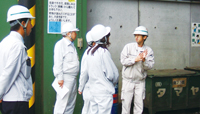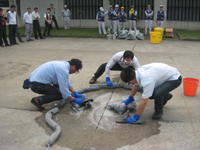Initiatives for Reducing Impacts on the Environment Back Number (2012)
Back to Latest Initiatives for Reducing Impacts on the Environment
Basic Approach
Plant effluents and emissions can be a source of water, air, and soil pollution that poses a threat to local communities. At the Minebea Group, we believe that harmony with the local communities is indispensible to our business activities, and as such, we are striving to reduce the impacts on the environment.
Results of FY2011 Initiatives
In order to ensure compliance with the environmental laws and regulations of each country and community, the Minebea Group has established environmental standards exceeding its legal requirements and undertakes daily compliance monitoring. In FY2011, there were no incidents which violated either the legal requirements or the Group's own standards. The Group also monitors the impact of its plants on the surrounding communities by conducting environmental patrols at all of its plants to ensure there are no leakages, foul odors, noise, or vibration caused by the plants.
Additionally, in FY2011, the Group created a new chemical substances database to more effectively manage the amounts of chemical substances used by the Group. We plan to begin operating the database in FY2012.
Plant Initiatives
Plant Wastewater Purification
Prior to releasing wastewater into rivers, Minebea Group plants use their own wastewater processing equipment to purify wastewater to within fixed environmental standards. These plants adhere to environmental laws of the countries and localities in which they operate, and independently monitor such wastewater discharges, including regular testing for such metrics as pH (Note 1), COD (Note 2), BOD (Note 3), SS (Note 4), and the oil content of n-hexane extracts (Note 5).
In FY2011, no anomalous monitored values were reported by any plant. In addition, no complaints relating to these metrics were received.
- Note 1. pH: A scale indicating whether substances are acidic or alkaline. pH7 is neutral. pH values below 7 indicate increasing acidity, while values above 7 indicate increasing alkalinity.
- Note 2. COD (chemical oxygen demand): The amount of oxygen consumed to oxidize organic substances (pollution) in water. COD measurement takes less time than BOD measurement, but is less reliable. COD is generally used as a metric in wastewater management for sea, lake, and marsh waters.
- Note 3. BOD (biological oxygen demand): The amount of oxygen required for bacteria to consume and decompose organic matter (pollution) in water. Higher values indicate greater degrees of pollution. Measurement takes several days. BOD is generally used to observe effluent water in rivers.
- Note 4. SS (suspended solids): The volume of substances suspended in water. The higher the number, the greater the degree of water pollution.
- Note 5. n-hexane extracts: Substances extracted from oils and detergents that are difficult to volatilize in water using a substance called n-hexane as solvent. In this report they signify mineral oils.
Regular Inspections of Waste and Recycling Stations (Japan, Thailand, China, etc.)

Employee of Hamamatsu Plant inspecting a waste disposal site
At each plant and office, there are types of waste which are difficult to reuse or recycle within the site. In these cases, the waste is disposed of through third-party waste disposal companies.
The Minebea Group selects reliable waste disposal companies and conducts regular inspections of their disposal sites to confirm the status of waste disposal and management. We will continue to cooperate with waste disposal companies to ensure that their waste disposal processes do not generate soil, water, or air pollution.
Completion of Soil Pollution Clean-up at Ichinoseki Plant

Clean-up work has been completed at the Ichinoseki Plant
In the past, some Minebea Group sites experienced soil and groundwater pollution from the use of chlorinated organic solvents containing volatile organic compounds (VOC). Cleanup of the contaminated plants and plant sites is proceeding under the Minebea Group's auspices.
We confirmed contamination at the Ichinoseki Plant and have voluntarily taken measures to clean up the plant site. The cleanup effort was completed in October 2011, and a report was submitted to the Ichinoseki public health center and the municipal office.
Management of PRTR-controlled Substances (Japan)
In accordance with the Pollutant Release and Transfer Register (PRTR) Law, all of our places of business in Japan manage the amounts of PRTR-controlled substances used and transported.
Reported Results for FY2011
| Control number | Substance name | Volume handled | Emission Volumes | Transfer volumes | ||
|---|---|---|---|---|---|---|
| Air | Water | Landfill | Waste | |||
| 71 | Ferric chloride | 4.99 | - | - | - | - |
| 309 | Nickel compounds | 1.19 | - | 0.03 | - | 0.75 |
| 384 | 1-bromopropane | 25.88 | 24.54 | - | - | 1.34 |
| 438 | Methylnaphthalene | 4.28 | 0.02 | - | - | - |
Damage Control Training for Chemical Substance Leaks (Shanghai Plant)

Training session at a hazardous materials storage area at the Hamamatsu Plant
Accidental leakage of chemical substances is a major risk in conducting machining operations. The Chemical Substances Management Group at Minebea's Hamamatsu Plant prepares for the possibility of such accidents and carried out damage control training for chemical substance leaks in October 2011.
Regular training maintains plant employee skills in such areas as the appropriate and prompt emergency use of liquid chemical absorbent—which is always available on site for the prevention of chemical substance leakage—as well as measures to clean up absorbent after use, and extinguishing chemical substances that have caught fire.
Emergency response training (China)

Damage control training for chemical substance leaks
The Shanghai and Xicen plants conducted emergency response training to educate personnel on procedures to take in the event of chemical substance leaks.
The Environmental Safety Committee at each plant conducts the training to minimize human injury and environmental pollution by taking appropriate measures in the event of a leak. The training is held annually for manufacturing division employees handling hazardous chemicals substances, suppliers of hazardous chemical substances, hazardous materials recovery companies, and cleaning companies.
In the FY2011 training, 58 employees from manufacturing divisions, 11 outside suppliers, and four personnel from a cleaning company participated, for a total of 73 trainees. Under the guidance of the Environmental Safety Committee's chemical substance management sub-committee and the local fire department, the participants received hands-on training on the use of absorption materials to prevent the spread of substances in the event of a hazardous chemical leak, along with first-aid measures and emergency contact procedures.
Future Issues and Goals
The Minebea Group continues to conduct business operations in compliance with environmental laws in Japan and around the world, and is proceeding with cleanup work in areas where it has caused environmental contamination in the past.














